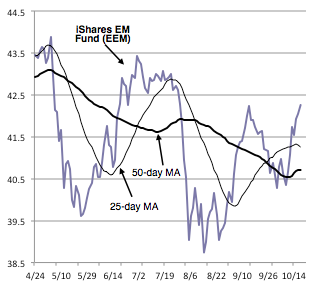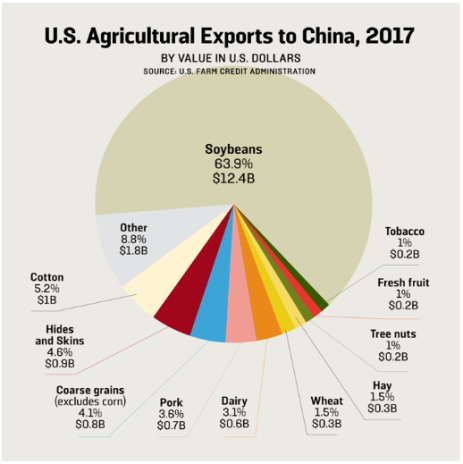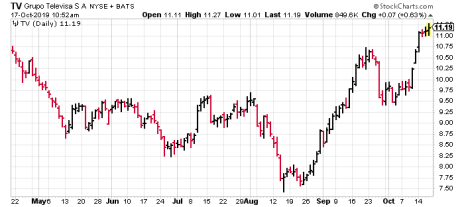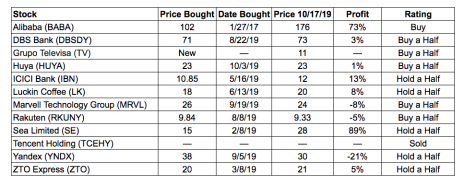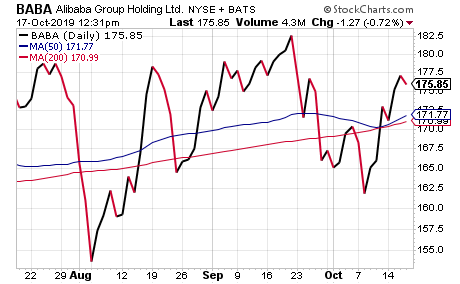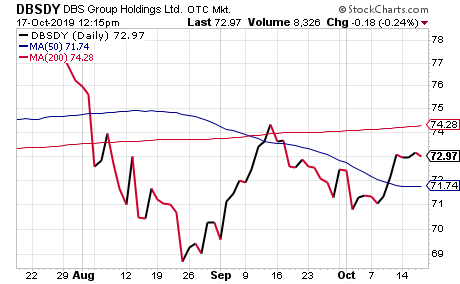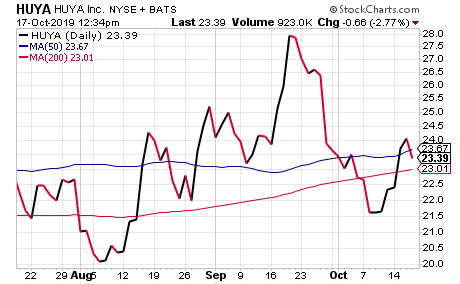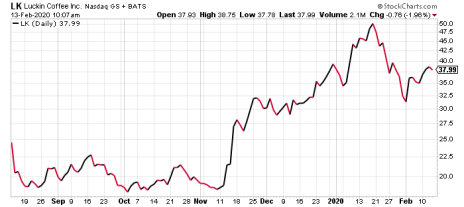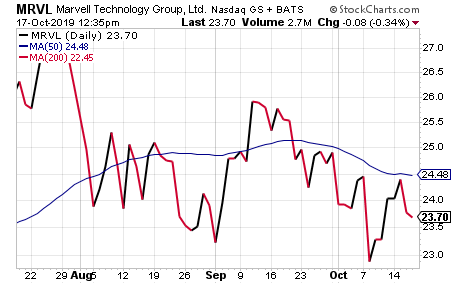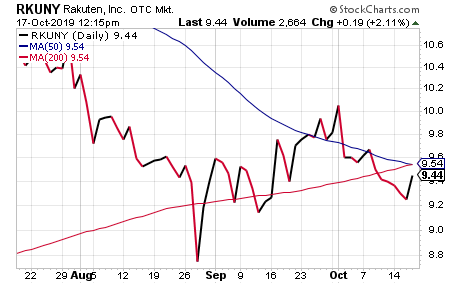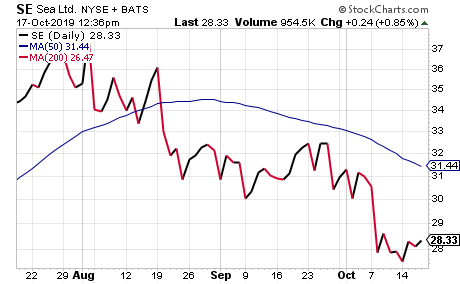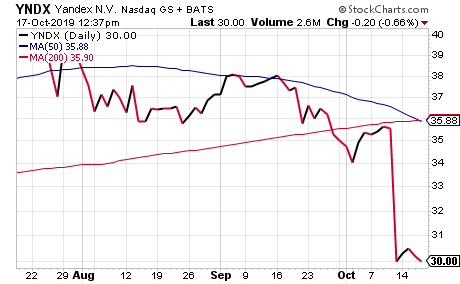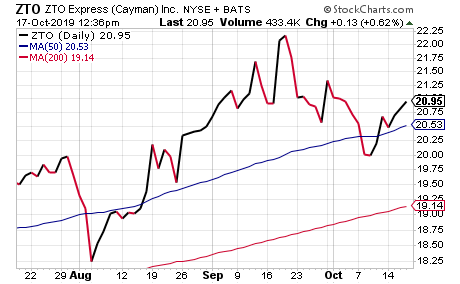Last week’s U.S.-China trade truce fell flat but the tone of emerging market and international stocks remains positive. The EEM began 2019 at 40 and moved nicely to 44 in late spring before coming back to 39 in late summer. Since then, EEM has been in a choppy uptrend to reach 42. Today we move south of the border for a new recommendation in a strong uptrend and way off its high.
Cabot Global Stocks Explorer 696
[premium_html_toc post_id="188803"]
Cabot Emerging Markets Timer
The Emerging Markets Timer is our disciplined method for staying on the right side of the emerging markets. The Timer is bullish when the index is above the lower of its two moving averages and that moving average is trending up.
Our Emerging Markets Timer remains positive, having passed its early-October test in fine fashion. You can see that the iShares EM Fund (EEM) came down to (slightly below) its lower (50-day) line at the beginning of the month, but basically held and has since reasserted itself on the upside—keeping the intermediate-term trend pointed up.
As we’ve written before, that doesn’t mean you should throw caution to the wind, as EEM and many stocks still have resistance to chew through from earlier this year. There are opportunities to be had, but being choosy on the buy side remains important.
U.S.-China Truce & Mexico’s Strategic Value
The tone of emerging and international markets was positive this week as in what can fairly be called a truce; America called off a new round of tariffs in return for promises by China to buy more agricultural products ($40-$50 billion worth, to be precise).
However, no agreement was signed and it looks like this temporary understanding is already crumbling as China is trying to remove previous tariffs before making any firm commitments. Below is the breakdown of agricultural exports to China, which is dominated by soybeans. Soybeans sourced in Brazil have already largely replaced many of these U.S. soybean exports and Maine lobster exports to China have been replaced by Canadian lobster exports to China.
Still, the truce tone was clearly positive news as many international and especially emerging markets gained ground.
Meanwhile, Hong Kong took center stage amidst an NBA controversy (started by a simple tweet from Houston Rockets general manager Daryl Morey) and China threatened unspecified “strong countermeasures” after the U.S. House passed a package of measures backing a pro-democracy movement that has rocked the former British colony for more than four months.
Hong Kong protesters are now targeting businesses they believe are tied to mainland China with boycotts and physical attacks. So far that has included Starbucks, where a Beijing-linked businessman owns the local franchise.
Meanwhile, the U.S. House of Representatives passed the Hong Kong Human Rights and Democracy Act, which subjects the city’s special U.S. trading status to annual reviews and provides for sanctions against officials deemed responsible for undermining its “fundamental freedoms and autonomy.”
China’s Loss is Mexico’s and America’s Gain
Let’s take a deeper look at the interesting triangle of trade and investment between Mexico, America and China.
One of America’s key advantages is its ideal geography.
America is a large continental state rich in resources with benign neighbors—Canada to the north and Mexico to the south, not to mention 6,000 miles of ocean to the west and 3,000 miles of ocean to the east.
According to management consulting firm AlixPartners, Mexico has surpassed China as the cheapest country in the world for companies looking to manufacture products for North American markets.
This could be good news for American manufacturers and, in an odd twist, American workers. The reason is that about 40% of the content of goods assembled in Mexico and shipped out as exports are made in America.
For stuff assembled in China, only 4% of the content is made in America. So U.S. imports of Mexican products are 10 times better for American workers compared with Chinese imports.
American firms still export three times as much to Mexico as they do to China. And Mexico, in turn, sends 80% of its exports back across U.S. borders.
Today’s recommendation is the seventh-largest Mexican stock by market value with a stock in a nice uptrend, but far below earlier highs.
Featured Stock
New Recommendation
Grupo Televisa (TV): Undervalued and in an Uptrend
Grupo Televisa is like having CBS, Comcast and 21st Century Fox tied together in one package.
The company owns an appealing group of businesses, including a dominant set of Mexican TV stations; a controlling stake in the country’s largest satellite TV business; and a 36% interest in Univision, the big U.S. Hispanic broadcaster. It’s also Mexico’s top provider of cable TV services and has a profitable programming contract with Univision that is one of its most prized assets.
The company has assembled the largest cable business in Mexico, with about 20% of the pay-TV market. Satellite and cable TV are much more important than broadcasting and produce recurring revenue streams. Cable is appealing because of ongoing subscriber growth, falling capital expenditures, and significant growth potential in data services, given the low penetration of high-speed Internet services in Mexico.
Its stock, currently trading at 10.65 per share, has seen better days and has struggled a bit with tough earnings comparisons in 2019 due to the Men’s World Cup in 2018.
But TV is still posting profits, with the stock in an uptrend, and it will benefit from easier comparisons in 2020. The last time the stock traded at these levels was in May 2004; it hit a high of 38 by June 2015.
While the Mexican economy and the peso have not been strong, Mexico should benefit from becoming a lower cost-manufacturing base than China and keep in mind that Mexican exports to America already contain 40% U.S. content while Chinese exports to America have only 4% U.S. content.
Finally, keep in mind that Mexico features very favorable demographics, where almost half of the country’s population is what we would term working age and 27% of Mexicans are under the age of 14. All of this is very positive for Grupo Televisa and TV stock and I encourage you to begin with a half position. BUY A HALF
Grupo Televisa (TV)
Building A, Avenida Vasco de Quiroga No. 2000
Floor 4 Delegacion Alvaro Obregon Colonia Santa Fe
Mexico City, DF 01210
Mexico
52 55 5261 2000
http://www.televisa.com
Model Portfolio
Updates
Alibaba (BABA) shares have been churning in the mid $160s but this stock still represents the best near and long-term quality play on the rise of China’s consumer class. Any sort of U.S.-China “deal” could move this stock to $200.
It dominates China e-commerce and its stock is valued attractively at about ten times expected 2020 earnings.
Baba’s goal is to build out from its current 730 million annual active users to over 1 billion users by the end of fiscal 2024.The company’s e-commerce business lends itself well to a natural monopoly as Baba has over a 50% market share. Alibaba’s cloud infrastructure business also benefits from its scale and lower costs.
To get more Baba will need to launch new products and services, tap into new more rural parts of China and expand into new overseas markets.
BABA can get back to the 200 level and beyond provided that trade tensions ease. I encourage you to buy a full position in this stock if you have not already done so.BUY A FULL POSITION.
DBS Bank (DBSDY) shares added a point this week which is a win for this high quality conservative play on Singapore and Southeast Asia financial services.
It is the largest and strongest bank in Southeast Asia and the leading consumer bank in both Hong Kong and Singapore. Its tentacles reach out through 200 branches in 50 cities. DBS produces steady profit margins, revenue, and earnings and is also increasing market share in consumer and corporate banking.
Despite all of these strengths, DBS is trading at only eleven times trailing earnings come with a 4.8% dividend yield. I encourage you to buy at these levels for this great core holding.BUY A HALF POSITION.
Huya (HUYA), our most recent recommendation and China’s leading e-sports platform and game-streaming brand, was off and running in its first week.
Huya has large, open pathway to grow beyond China in emerging markets. This is important since 72% of frequent e-sports viewers live outside of the U.S. and Europe and the company is expanding aggressively in Asia-Pacific and Lain America with the logistical support of Tencent.
Its latest quarter posted monthly users growing 57% year over-year to reach 144 million and revenue growth of 94%. In addition, gross margins improved slightly and sales and marketing expenses are only 6% of revenue.
Huya, now trading just over 23 and could break out around its March 2019 high of 30. This is an aggressive, high growth China idea so I advise putting in place a 20% trailing stop loss and starting with a half position.BUY A HALF POSITION.
ICICI Bank (IBN) shares moved up 5% this past week despite the IMF reducing India’s projected economic growth into 2020.
IBN is a solid India play in and there are still 191 million Indians without a bank account, which means a lot of potential new customers. This is a good entry point to take a stake in IBN if you have not yet done so.HOLD A HALF POSITION.
Luckin Coffee (LK) shares gained 6% this week and its CFO has publicly stated it plans to be a breakeven by the end of next year. Its second quarter had high sales and marketing expenses are a cause of concern but can be dialed back in the future.
Luckin believes there is room for more than Starbucks in a market of 300 million plus middle class consumers. Its strategy to compete with Starbucks is a combination of quality, convenience and affordability with a price target of 50% of Starbucks. Most of its shops are set up for takeaway and delivery rather than the Starbucks model of a place to meet and work.
Luckin is an aggressive stock that has only one quarter of operations under its belt since its IPO earlier this year.HOLD A HALF POSITION.
Marvell Technology Group (MRVL) shares edged up this week but hasn’t done all that much since being added to the portfolio as growth stocks in general have stalled.
Marvell is a leader in web-enabled devices that collect, send and act on data using sensors, processors and other hardware to talk to each other.
The Marvell team has created a franchise that is a powerhouse in Storage Networking, embedded processing, security, and encryption.
The company’s embedded processors and products are cutting-edge and already generating multibillion-dollar annual sales. Marvell is headquartered in Bermuda with operations in the U.S., China, Taiwan, Japan, India, South Korea, Vietnam and several other countries.
New markets are emerging in which Marvel has a first-mover advantage such as virtual reality, drones, data integration and consumer and industrial robotics. I have high expectations for this stock and encourage you to start with a half position if you have not yet done so. BUY A HALF POSITION.Rakuten (RKUNY) shares have been lackluster over the last few weeks since it announced a six-month delay for the launch of its wireless network.
Rakuten is a well-diversified conglomerate with tentacles throughout Japan and has plenty of running room for international expansion. Its loyalty membership program is more than 100 million strong and it is Japan’s #1 Internet bank, #1 credit card and one of the country’s leading travel platforms.
Rakuten is the seventh-most visited website in Japan with 490 million visitors in September with an average length of visit of over six minutes. The company’s core business is as an Internet sales platform akin to Amazon with its market share in Japan at about 25%.
And the stock is trading at just 10 times trailing earnings, booked a 16% increase in revenue during its latest quarter, and offers an impressive 19% return on equity. If you haven’t yet bought shares, this would be a good time to buy a half position.BUY A HALF POSITION.
Sea Limited (SE) shares are sitting at 28, up over 100% since we got in, but it has come back from a 36 high two months ago. We currently have SE rated as a hold and had previously advised selling half your shares to take some profits off the table. The next quarterly report is expected on November 18.
One of the key drivers of Sea Limited (SE) is its Garena gaming group, which is estimated to grow 160% in 2019. The company will also soon launch Call of Duty: Mobile. Sea has a license agreement with Tencent to sell its games in Southeast Asia. The second driver is its Shopee ecommerce platform, which some analysts believe could grow revenue 7x to reach $2 billion in 2021.
We need an uptrend before moving Sea to a buy.HOLD A HALF POSITION.
Yandex (YNDX) shares were unfortunately slammed last Friday as the Russian government announced that it might restrict foreign ownership in Russian technology companies beginning in 2020.
Shares recovered and stabilized early this week and trade at only six times earnings. Some analysts have suggested that Yandex might be able to circumvent this speed bump since it is incorporated in the Netherlands and could issue another class of shares for foreign investors.
Yandex, is primarily viewed as only a search engine play that has cornered 57% of the Russian market. Alfa Bank has an outperform rating and a price target of 48, implying 58% upside potential. It is expected to announce third-quarter earnings on October 25 and I’m moving the stock to a hold for the time being.MOVE FROM BUY A HALF TO HOLD A HALF.
ZTO Express (ZTO) shares were up 5% over the last week and if this uptrend continues, I will move this from a hold to a buy rating.
Based in Shanghai, ZTO is one of the largest express delivery companies, not just in China but globally. It offers services to millions of traditional merchants, e-commerce sites, and online sellers using a proprietary tracking system, a state-of-the-art transportation management system, and more than 5,000 trucks, as well as hundreds of business partners.
And ZTO serves foreign customers through partnerships with many international express delivery companies. HOLD A HALF POSITION.
The next Cabot Global Stocks Explorer issue will be published on October 31, 2019.
Cabot Wealth Network
Publishing independent investment advice since 1970.
CEO & Chief Investment Strategist: Timothy Lutts
President & Publisher: Ed Coburn
176 North Street, PO Box 2049, Salem, MA 01970 USA
800-326-8826 | support@cabotwealth.com | CabotWealth.com
Copyright © 2019. All rights reserved. Copying or electronic transmission of this information is a violation of copyright law. For the protection of our subscribers, copyright violations will result in immediate termination of all subscriptions without refund. No Conflicts: Cabot Wealth Network exists to serve you, our readers. We derive 100% of our revenue, or close to it, from selling subscriptions to its publications. Neither Cabot Wealth Network nor our employees are compensated in any way by the companies whose stocks we recommend or providers of associated financial services. Disclaimer: Sources of information are believed to be reliable but they are not guaranteed to be complete or error-free. Recommendations, opinions or suggestions are given with the understanding that subscribers acting on information assume all risks involved. Buy/Sell Recommendations: All recommendations are made in regular issues or email alerts or updates and posted on the private subscriber web page. Performance: The performance of this portfolio is determined using the midpoint of the high and low on the day following the recommendation. Cabot’s policy is to sell any stock that shows a loss of 20% in a bull market or 15% in a bear market from the original purchase price, calculated using the current closing price. Subscribers should apply loss limits based on their own personal purchase prices.

